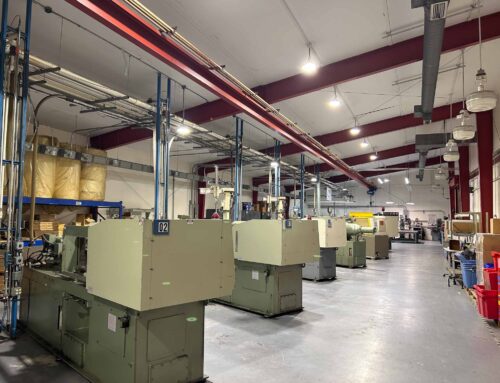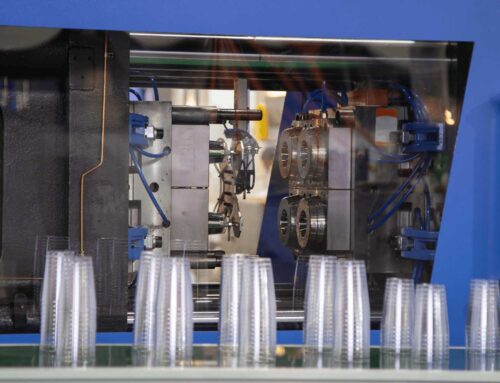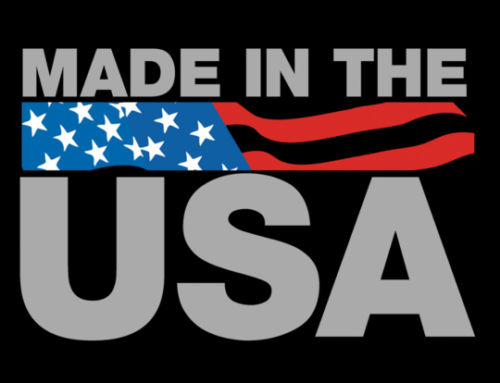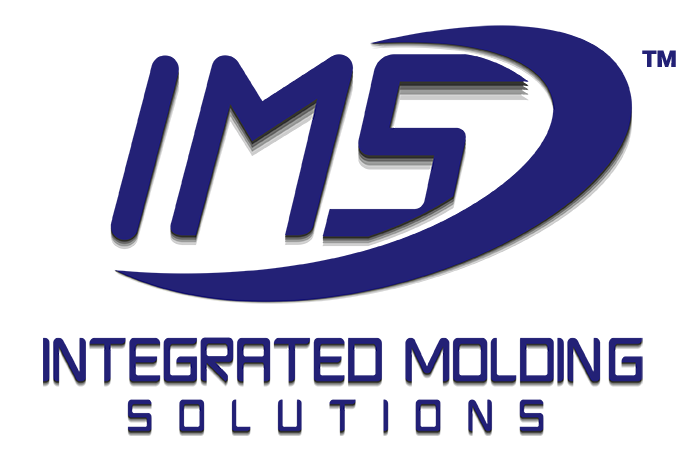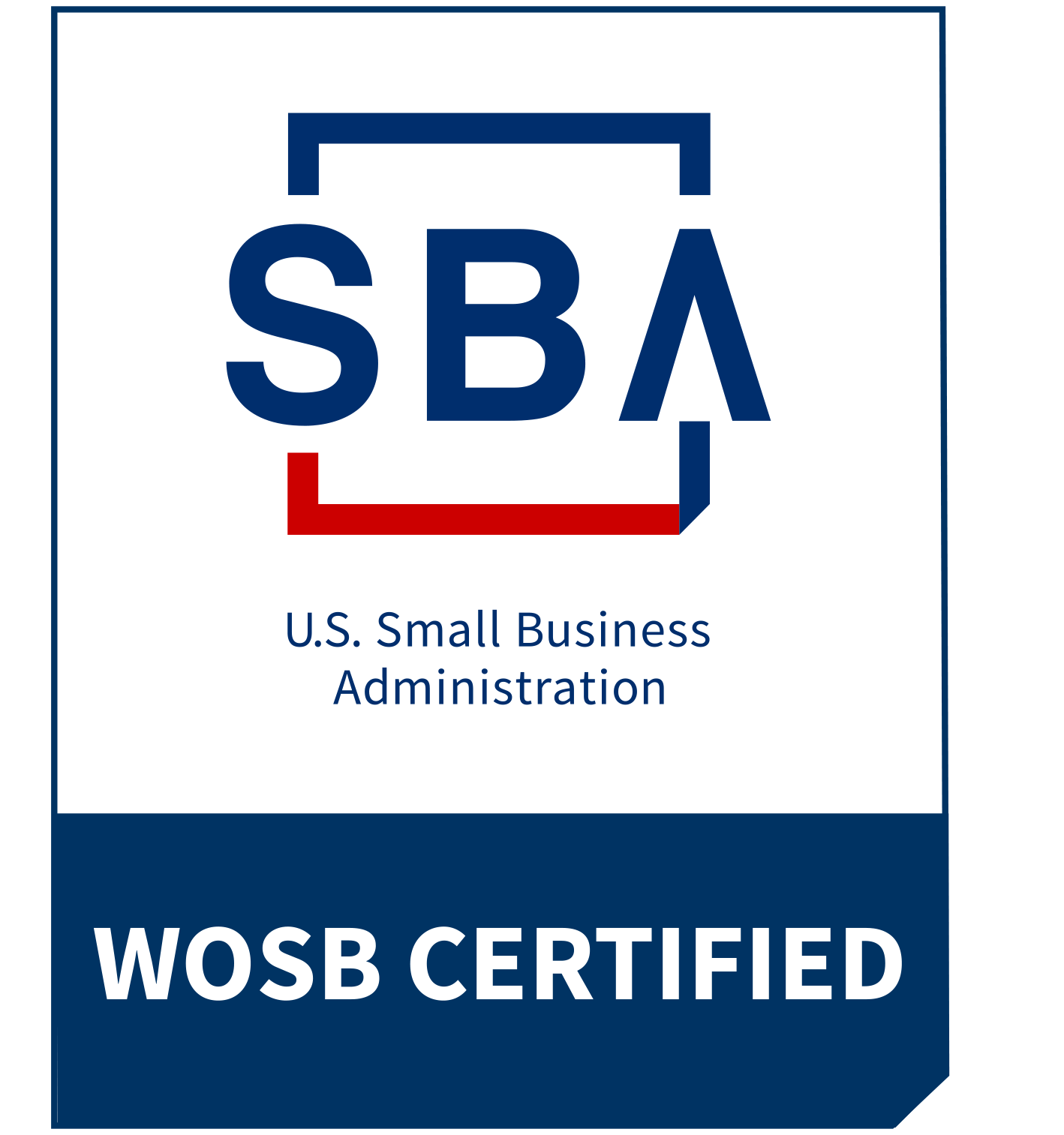Plastic Injection Molding Material Selection
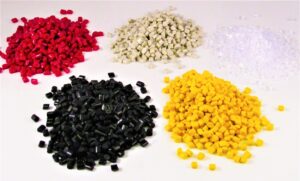 Plastic can be found in just about every consumer product or used in almost every industry in some shape and form. Electronics, consumer products, automotive, healthcare, and even aerospace all use plastic materials to make endless parts all with different functions and specifications. Therefore, plastic material selection is one of the most important steps when manufacturing any plastic product. At Integrated Molding Solutions, we always review and consult on injection molding materials selection before undertaking any project. In this article, IMS shares our decades of plastic industry knowledge, in this injection molding materials selection guide.
Plastic can be found in just about every consumer product or used in almost every industry in some shape and form. Electronics, consumer products, automotive, healthcare, and even aerospace all use plastic materials to make endless parts all with different functions and specifications. Therefore, plastic material selection is one of the most important steps when manufacturing any plastic product. At Integrated Molding Solutions, we always review and consult on injection molding materials selection before undertaking any project. In this article, IMS shares our decades of plastic industry knowledge, in this injection molding materials selection guide.
Properties to consider when selecting injection molding materials
There are several important properties to consider for selecting injection molding materials for any plastic product. These include the desired tensile strength, flexural modulus (bending stiffness), Izod impact (toughness), electrical insulation, temperature resistance, chemical resistance, FDA compliance, and cost of the final product.
The first property to consider when selecting injection molding materials is the product’s desired tensile strength. Tensile strength is the resistance to being pulled apart, typically measured in PSI (pounds per square inch). Similarly, another material property to consider is Izod impact (notched) or toughness. The Izod impact test is an ASTM standard method of determining the impact resistance of materials. This is done by swinging an arm into the notched sample, recording the energy required to break the part, which is measured in ft·lb/in2.
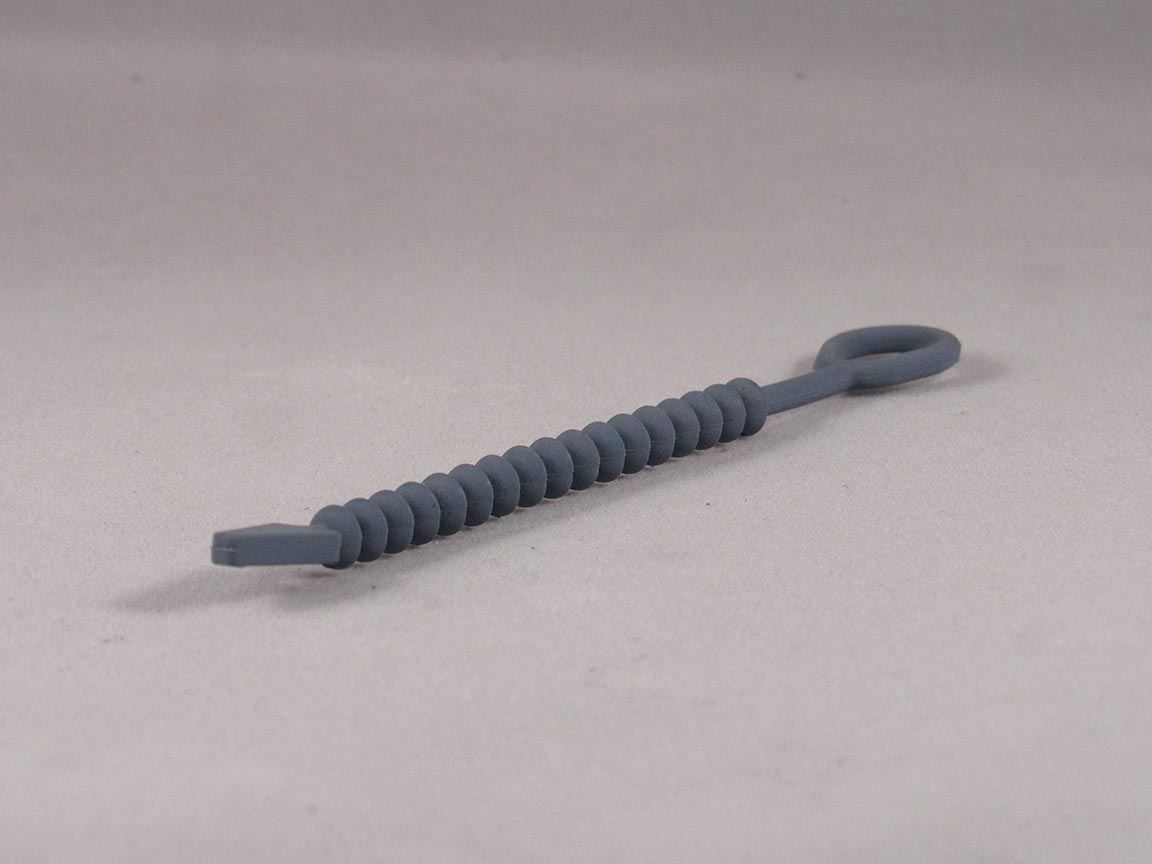 Another property to consider when selecting your plastic material is the material’s flexibility or bending stiffness. Also known as flexural modulus, the material’s stiffness is measured in psi. Next, is electrical insulation properties, or dielectric strength. Typically measured in volts per micrometer (v/mil), to determine how well the plastic part will prevent the flow of electrical charge. While these are accurate for certain standards, sometimes we have to use metric units due to the material info we are given, or doing tests in other standards (ISO or DIN for example).
Another property to consider when selecting your plastic material is the material’s flexibility or bending stiffness. Also known as flexural modulus, the material’s stiffness is measured in psi. Next, is electrical insulation properties, or dielectric strength. Typically measured in volts per micrometer (v/mil), to determine how well the plastic part will prevent the flow of electrical charge. While these are accurate for certain standards, sometimes we have to use metric units due to the material info we are given, or doing tests in other standards (ISO or DIN for example).
Chemical resistance is also important because this will determine how well the plastic can resist being degraded by certain chemicals better than others. For example, gasoline will melt polystyrene (basically making napalm), but not polyethylene (which plastic gas cans are made of). Therefore, it is important to identify what the finished product will come in contact with and pick a compatible material. Along this note, FDA compliance is an important factor when dealing with medical or consumer products that must be approved for human contact.
How the injection molding material reacts to heat is important to consider when comparing thermoplastic materials. The thermal properties will determine the max and min working temperature, the melting temperature, and can determine how the material will react in the mold and as it cools. Injection molding pressure and flow rate of material can cause shrinkage and dimensional instability if not chosen carefully.
Lastly, cost is important for obvious reasons and can change in numerous ways, from availability, and material properties, to the use of material additives. If multiple plastic materials will meet your property requirements then cost may be the determining factor to produce your product to your specifications.
Amorphous vs Semicrystalline Thermoplastics
There are two types of thermoplastic materials that we commonly use at Integrated Molding Solutions, amorphous and semicrystalline. Amorphous thermoplastic material can be highly transparent and has good formability with a lower melting temperature range. While amorphous thermoplastics have poor chemical resistance, this provides an easier bond to other materials using adhesives or solvents.
On the other hand, semicrystalline thermoplastic material has great fatigue and stress cracking resistance making it the perfect material for bearing and wear. However, semicrystalline thermoplastic material can have high chemical resistance and difficulty bonding to other parts using adhesives or solvents.
Amorphous and Semicrystalline thermoplastic material comparison chart.
| Amorphous Thermoplastics | Semicrystalline Thermoplastics |
| Soften over a wide temperature range | Sharp melting point |
| Good formability | Poor formability |
| Transparency | Opaque |
| Poor chemical resistance | Good chemical resistance |
| Bonds well using adhesives or solvents | Difficult to bond using adhesives or solvents |
| Prone to stress cracking | Resistant to stress cracking |
| Poor fatigue resistance | Good fatigue resistance |
| Structural applications only | Good for bearing and wear |
| Acrylic, PC, ABS, PS | LDPE, HDPE, PP, PET |
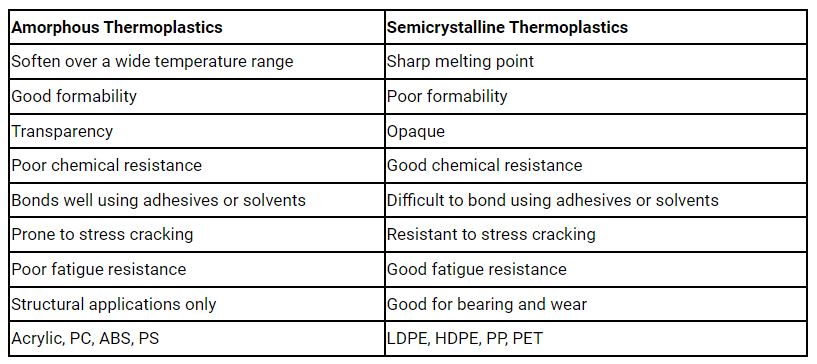
When comparing plastic materials, use this plastic materials comparison chart to identify which injection molding materials will meet the product specifications. One of the many benefits of working with a professional plastic fabrication company is their knowledge of plastic material alloys, fillers, and additives. Custom plastic injection molding materials can be engineered to meet required product properties that common plastic molding materials cannot.
Plastic Material Comparison Chart
| Material | Approximate Tensile Strength | Flexibility | Impact Strength | Electrical Insulation | Temperature Resistance | Chemical Resistance | FDA Compliant | Cost (low to high) | Water Resistant |
| Acrylic (PMMA) | 8000 psi | low | low | no | high | strong | no | medium | yes |
| Acrylonitrile Butadiene Styrene (ABS) | 5900 psi | high | high | no | low | medium | no | medium | yes |
| Nylon Polyamide (PA) | 12400 psi | high | high | yes | high | strong | yes | high | yes |
| Polycarbonate (PC) | 9500 psi | high | high | no | high | weak | yes (can contain bisphenol A, or BPA) | high | yes |
| Polyethylene (PE) | 1400 psi (LDPE) 3480 – 6530 psi (HDPE) 800 – 13100 psi (PET) |
medium (LDPE) low (HDPE) high (PET) |
high (LDPE) high (HDPE) low (PET) |
yes | low | strong (LDPE) strong (HDPE) strong (PET) |
yes | low | yes |
| Polyoxymethylene (POM) | 6400 – 10600 psi | medium | high | yes | high | strong | yes | high | |
| Polypropylene (PP) | 4800 psi | high | medium | yes | medium | strong | yes | low | yes |
| Polystyrene (PS) | 2560 – 7690 psi | medium | high | no | medium | yes | low | yes | |
| Thermoplastic Elastomer (TPE) | 290 – 8200 psi | high | high | no | low | strong | no | high | yes |
| Thermoplastic Polyurethane (TPU) | 4060 – 13900 psi | high | no | high | strong | yes | medium | yes | |
| PC/ABS | 7000 psi | low | high | no | medium | strong | yes | low | yes |
| PC/PBT | 7830 – 12000 psi | low | high | yes | high | medium | yes | medium | yes |
| PPE/PS | 6500 psi | low | medium | no | high | medium | yes | medium | yes |
Plastic Injection Molding Materials
Acrylic (PMMA) – Acrylic, also known as poly(methyl methacrylate), is an amorphous thermoplastic. It’s good for structural applications due to its formability and ability to form tight tolerances with injection molding. Acrylic is clear and strong, making it a great, lightweight alternative for glass. Also, PMMA resists sunlight and will not degrade from water, making it perfect for outdoor windows and as a transparent enclosure.
Acrylonitrile Butadiene Styrene (ABS) – ABS is another amorphous thermoplastic with a low melting point. As an opaque polymer, ABS is compatible with colorants and has multiple options for various textures and surface finishes. Known for its strength and impact resistance, ABS however has weak resistance to UV rays, weather, high friction, and solvents, and it generates heavy smoke when burned, but this can be fixed with additives. Acrylonitrile Butadiene Styrene is best used for electronic components and coverings, as well as automotive components, consumer goods, and sports equipment.
Nylon Polyamide (PA) – Polyamide, otherwise known as nylon, is a synthetic material. Nylons’ high-temperature resistance does make it prone to shrinkage and inadequate filling of the mold. It can be degraded by sunlight and has poor resistance to strong acids and bases, but additives and fillers can help with these shortcomings. Best for snap-fit closures like caps, plastic threaded inserts, casings, gears, and electrical connectors.
Polycarbonate (PC) – Polycarbonate is a strong and lightweight amorphous thermoplastic with good transparency. 250 times stronger than glass, polycarbonate still has uniform mold shrinkage making it easy to use for injection molding. However, PC contains BPA, so not recommended for food prep or storage. When colored, polycarbonate retains its strength. Therefore, polycarbonate thermoplastic is best used for consumer goods or housing products.
Polyethylene (PE) – Polyethylene is a consumer-grade polymer that can be selected by density making it globally, the most commonly used plastic. Three main types of polyethylene are high density (HDPE), low density (LDPE), and polyethylene terephthalate (PET, PETE). Polyethylene is a low-cost plastic material that has high resistance to chemicals and moisture. PE plastics are best used to injection mold larger items therefore they are frequently used for blow molding films and bottles.
Polyoxymethylene (POM) – Polyoxymethylene, commonly known as acetal, is a low friction, high stiffness, general purpose semicrystalline thermoplastic. The engineered thermoplastic has low water absorption, good chemical resistance, and demonstrates excellent dimensional stability. There are two types of POM plastics: homopolymers and copolymers, with the differences lying within their dimensional stability and creep resistance, whereas a copolymer does better over time in both categories. Due to its low friction, the most common products made with injection molding polyoxymethylene are metal replacement parts like bearings, gears, conveyor belts, screws, and more.
Polypropylene (PP) This semicrystalline thermoplastic is the second most commonly used plastic in the world for its flexibility. It is very similar to polyethylene but slightly harder and more heat-resistant. When used in injection molding, it can be recycled multiple times and blended with other plastic materials very well. However, polypropylene is extremely flammable (fixed with flame retardant additives), and difficult to bond – which also means it’s one of the materials that is harder to paint or fasten. With its low density, this commodity plastic is best used for sporting goods, power tools, living hinges for plastic bottles, and storage containers.
Polystyrene (PS) – Another commodity plastic is polystyrene. This amorphous thermoplastic plastic resin can be broken down into two basic types: general-purpose polystyrene (GPPS) and high-impact polystyrene (HIPS). GPPS is known as crystal-clear polystyrene but is prone to cracking. HIPS has a more matte finish and is not transparent but is the stronger of the two. Polystyrene thermoplastics are inexpensive, lightweight, and resistant to moisture and gamma radiation, making them excellent to sterilize medical devices. While injection molded PS is recyclable it is non-biodegradable. Polystyrene is best suited for injection molding medical, optical, and electronic plastic parts, but is also used to injection mold some consumer goods.
Thermoplastic Elastomer (TPE) Thermoplastic elastomer is a blend of rubber and plastic materials, so it performs like rubber but is processed like plastic and is more recyclable. It has shorter mold cycles and supports two-shot injection molding, making it easier and less expensive to mold than rubber. TPE can lose rubber properties at high temperatures, but it’s the best plastic material for impact resistance. TPE could be used for footwear, auto parts, pet products, and medical applications like breathing tubes, ventilation masks, and catheters.
Thermoplastic Polyurethane (TPU) – Thermoplastic Polyurethane is a type of TPE but can be injection molded into a harder rubber with its high durometer. TPU is highly popular due to its ability to handle extreme temperatures and its resistance to chemicals, oils, and abrasion. It comes in commercial, medical, and industrial grades, making it great for medical devices, electronic casings, shoes, consumer goods, and wheels.
Injection Molding Material Alloys
PC/ABS – An alloy combination of Polycarbonate and Acrylonitrile Butadiene Styrene. PC/ABS provides a strong, stiff, and heat-resistant alloy, taking the best properties of these two amorphous thermoplastics. Its low shrinkage lowers the chance of injection molding defects making it perfect for components in electronics or automotive industries.
PC/PBT – PC/PBT is an alloy consisting of one amorphous thermoplastic (polycarbonate) and one semicrystalline thermoplastic (polybutylene terephthalate). An engineering polymer that has good chemical resistance, temperature resistance, and mechanical strength, PC/PBT is typically used for insulating components in electronics and the electricity industry.
Filler Selection for Injection Molding Materials

Glass filled PA
If you need to increase the material’s strength without sacrificing other properties, the addition of fillers can be a perfect solution. Glass, carbon, and talc are the three most common fillers to achieve an increase in stiffness and strength. By combining our material with the selected filler, we create a custom material consisting of 5%-60% filler. The higher percentage of filler used, the more the surface quality of the final product will be affected.
When comparing plastic material fillers, glass fiber is the most common to use for injection molding. Glass fibers provide reinforced strength and low density for a reasonable cost. Carbon fibers are a more expensive filler but can be used as a colorant, pigment, UV barrier, and antioxidant. Not only do carbon fibers reinforce the strength of the plastic, but they provide excellent resistance to creep, break stress, fatigue, and corrosive environments. Many companies in the automotive industry use carbon fiber fillers to produce lightweight parts because of the strength and durability it adds to plastic. Another plastic material filler we use at Integrated Molding Solutions is talc. Combining talc with polypropylene greatly increases the stiffness and heat resistance while reducing mold shrinkage and cycle time. Talc is also less abrasive than glass and can provide a better surface for finishing.
Additives Selection for Injection Molding Materials
If you are still unable to find a plastic material with the properties to meet your product’s specifications, there is a final alternative. Integrated Molding Solutions will work with you to engineer the perfect injection molding material combined with additives. Additives manipulate the plastic material’s properties without as large of a material composition percent change as using fillers.
Additives can affect plastic parts in various ways. Simple modifications like changing the thermoplastics color, to manipulating the properties to provide self-lubricating or anti-static capabilities. Another example is the addition of foaming agents to turn polystyrene into Styrofoam. With additives, we can create a car bumper to withstand the impact of an accident, or an airplane component that can handle creep resistance from its usage cycle.
Get Help Selecting Plastic Injection Molding Materials
Integrated Molding has decades of plastic manufacturing experience. Let us guide you from concept through design, mold creation, material selection, production, parts assembly, to finished product. Join us in our mission to provide environmentally responsible plastic products to grow businesses and leave a positive impact on the world.


